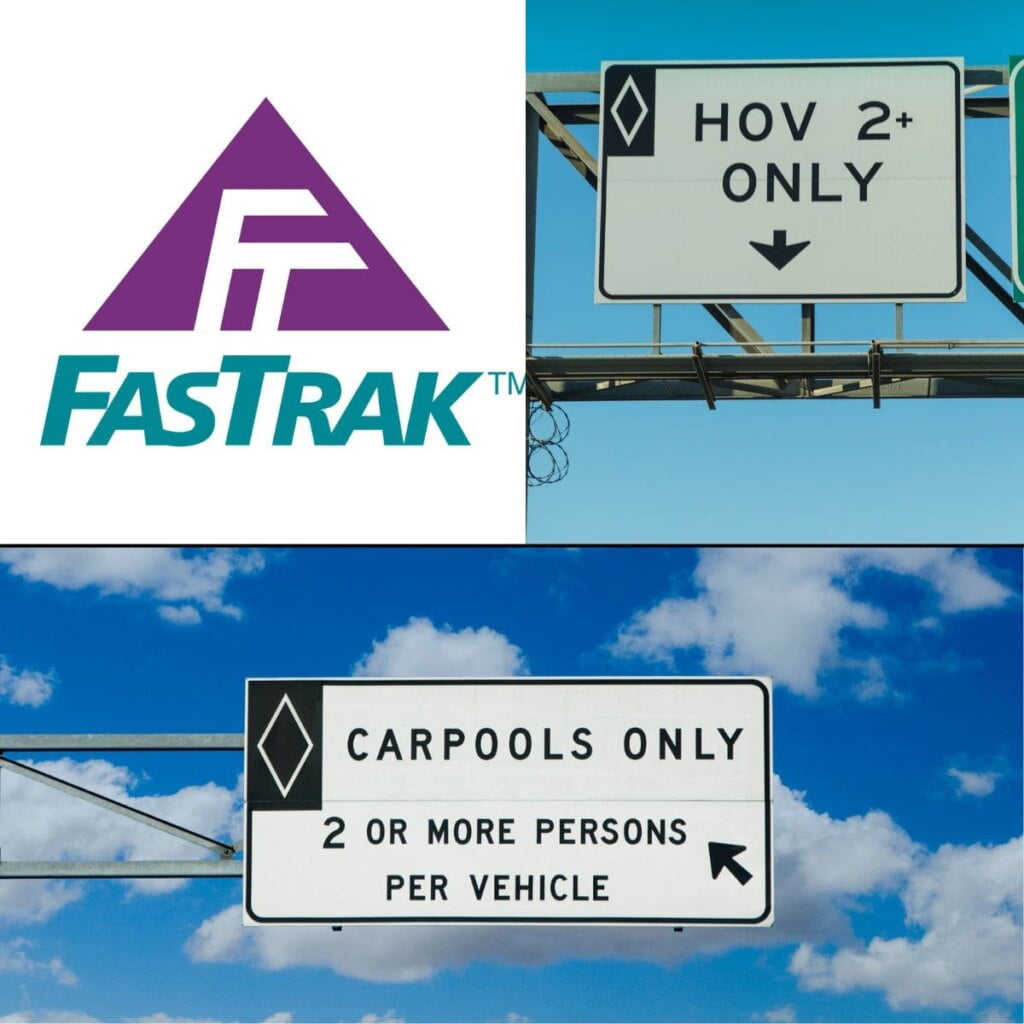What is the difference between a carpool lane, an HOV lane, and HOT lanes? If the term FasTrak is new to you, or if you haven’t driven in California in a while, the information below will be very helpful for navigating the California highway system.

What Is FasTrak?
FasTrak is an electronic toll-paying option in California that lets drivers pay automatically from accounts that can be pre-paid in advance. When you use the service you are provided with a transponder you install in your vehicle, which automatically deducts the toll from roads such as State Route 73, S.R. 133, S.R. 241 and and S.R. 261.
These are described as “limited-access, private highways in Orange County operated by The Transportation Corridor Agencies”. These are not operated by the state of California. You can also use FasTrak to navigate Express Lanes.
Learn more about FasTrak and set up an account here.
Car Pool And Express Lanes
When driving in parts of Orange County, you will notice many freeways have carpool lanes, and there are parts of the California that offer carpool and express lanes. These Express Lanes are specifically marked and identified, and when active, they require a toll or fee.
Not all car pool lanes and Express Lanes are designated as such 24/7. Some may be part-time and will be marked as such where applicable.
Carpool lanes do not require a fee to use.
What Are Express Lanes?
An Express Lane is one that offers a faster and easier commute (in theory) for a fee. Express Lanes are typically marked with a sign overhead and indicators directly on the pavement.
Overhead signs display the Express Lane toll rate for a specific destination. You will not stop for a toll booth here, there are no barriers or gates, and you don’t slow down to pay. The FasTrak transponder will register your toll, and you can only use FasTrak to pay on these roads. Your transponder must be properly mounted for it to work.
Some Express Lanes may be for-pay during peak traffic hours and completely open to the public in off-peak times. When these off-peak times occur, the overhead sign will indicate that the lane is OPEN to the public, including those who do not have FasTrak accounts.
Is A High-Occupancy Toll Lane (HOT) The Same As An Express Lane?
Some parts of the California Highway System are referred to as both Express Lanes and High Occupancy Toll Lanes (HOT). What do you need to know about HOTs? Mainly that if you are a single-occupant driver you may use the HOT if you pay the toll using FasTrak.
However you are NOT permitted to use an HOT lane if your vehicle is restricted to a 55MPH speed limit. One example is the HOT lane on I-680 in the San Francisco Bay area. You may be required to carry a FasTrak transponder in order to use an HOT lane.
What Are Car Pool Lanes?
Some parts of the California Highway system are restricted to carpools only during peak travel hours. These are referred to informally as carpool lanes, but are also referred to as High Occupancy Vehicle (HOV) lanes.
Drivers should know that while these lanes are restricted during rush hour, it is permitted to drive as a single occupant if the lane is free during off-peak travel times. Signs are typically posted along the HOV lane telling you when the lane is restricted to carpools only. You may encounter more of these part-time car pool lanes the further north in the state you go.
What Are Part-time High-Occupancy Vehicle (HOV) Lanes?
Some lanes are restricted to carpools only during high-use commute hours. It is legal for single-occupant vehicles to use the HOV lanes if it is outside those HOV hours of operation. Signs will be posted along the HOV lane telling you when the lane is restricted to carpools only. These part-time HOV lanes are most common in northern California.
How Much Does The Toll Cost To Use These Lanes?
Express lane, carpool, and other tolls are subject to change depending on traffic. As you might guess, tolls go higher as traffic increases. Tolls drop with traffic drops. The rates themselves are established and collected by FasTrak.
Carpool lanes are free to use by all vehicles that meet the required minimum occupancy.
Do I Have To Live In California To Pay My Tolls Via FasTrak?
No. FasTrak is open to anyone with a mailing address in the United States. You can purchase a FasTrak transponder tag in a retail store then activate it using the FasTrak official site. There are no account maintenance fees; all you pay for is your toll.

